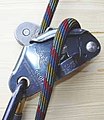Belay device

Belay devices are used when climbing to secure the climber. They enable the belayer to handle and control the safety rope depending on the situation by applying a braking force. Therefore they are called braking devices in the standard language. A belay device must generally support the following four situations:
- Issue rope - when belaying lead (belaying rope from below)
- Retrieve the rope - when top rope belaying and when securing a second climber (rope securing from above)
- Holding a fall or a climber hanging in the rope
- Controlled lowering of the climber by the belay partner
In addition, all belay devices can be used to abseil independently on the fixed single rope strand , but this is not very common among climbers. For the usual abseiling on the deflected double rope line, only belay devices that can accommodate two rope lines and brake at the same time can be used.
Since in all of these cases the human hand cannot hold the load of an adult on a rope, a brake booster by the belay device is necessary.
Manual braking devices
Belay devices, which increase the manual braking force of the holding hand, but do not block it completely in the event of a fall, belong to the manual braking devices or dynamic belay devices . You achieve the braking effect through the stitch principle - the clamping of the rope between you and the carabiner - and rope friction through repeated deflections according to Euler / Eytelwein .
Devices of this class approved in Europe must meet the standard EN 15151-2, which defines the requirements and test methods for manual braking devices. In particular, the device must withstand a pull of 7 kN with a fixed rope without breaking or releasing the rope (static strength). If there is a suspension eyelet to catch up with a second mountaineer (guide position), the device must withstand 8 kN, also if it can be used as a safety anchor. Furthermore, manufacturer, standard and model identification as well as the indication of the smallest and largest rope diameter are required.
The standard does not place any requirements on the dynamic braking properties or the brake booster of the device. However, there are experience reports from mountain sports safety research that examined the braking force as a function of the hand holding force, the rope diameter, the rope surface and the type of device. The V-shaped design of braking grooves has an advantageous effect on modern tubers, which adapt to different rope diameters. These models have braking values of 2.2–2.3 kN for ropes in the range 8.9–10.5 mm and 237–284 N manual force on the brake cable.
With 56% (as of 2012) - before the publication of the semi-automatic recommendation of the German Alpine Club - the tubes were the most widespread.
A single carabiner can also act as a belay device. To do this, the belayer uses the half-mast throw protection . It used to be the most common method and is still found today, especially on multi-pitch routes. Even today, mastering it is fundamental for many climbers, as it does not require any special equipment. The rope generates the braking force of 2.2–2.3 kN by means of a half-mast cast. In theory, any carabiner could be used, but due to the high safety requirements, climbers only use HMS carabiners .
The figure eight is also suitable as a belay device . Originally developed for abseiling, the braking force is also sufficient to hold a fall, but at 1.7–2.0 kN it is less than with Tuber and HMS. Today, however, it has largely been replaced by modern devices.
The cutting plate was the first mechanical rope brake and ancestor of the tube. Later superseded by other devices, today it is experiencing a partial renaissance in modern form when securing secondary climbers.
Semiautomatic
Semi-automatic devices are safety devices that automatically and completely block in the event of a sudden pull, such as that which occurs in a fall. The term semi-automatic refers to the mechanism which, although it offers a higher safety reserve, can nevertheless fail under certain conditions, which is why the belayer must always hold the brake cable. Requirements of this class are defined in the standard EN 15151-1.
The best known representative of the semi-automatic devices and also the first of this class is the Grigri . I'D S , Cinch, EDDY and Matik have a similar mechanism . The Revo was released in 2018 as a tuber secured with a centrifugal brake. The semi-automatic machines also include Sirius and Zap-O-Mat with different mechanics. The Sirius can also take two strands of rope, which is a rare feature in semi-automatic machines.
Although semi-automatic machines offer a plus in safety reserves, operation requires more thorough training. Due to its complexity, more operating errors are possible and the belayer must not completely rely on the automatic system. A user needs to know the situations in which the brake mechanism can be levered out. Semi-automatic machines accounted for 50% of ambulance missions due to errors when lowering in DAV climbing gyms between 2012 and 2014, although their prevalence is only 40%.
In addition, complete blocking prevents the impact force from being absorbed by the device. With a little practice, however, a fall can also be cushioned with a body-dynamic safety device in order to reduce the stress on the climber and the safety chain.
The Revo wants to avoid these weaknesses . Device dynamic backup is possible with it. Typical operating errors of other devices are conceptually avoided.
Autotubes
Self-blocking tubes are a fairly new class. Similar to the semi-automatic machines, these hybrids hold the rope independently and completely in the event of a fall, but they have no moving parts, but instead generate the braking effect in conjunction with the carabiner. Therefore, the compatibility between the carabiner and the so-called "autotube" is crucial and not every carabiner is suitable for every device. Some manufacturers therefore sell these devices in a set with a suitable carabiner.
Although these safety devices are self-locking, they are tested according to the EN 15151-2 standard, which also includes manual braking devices. Due to their function, however, the Autotubes climbing scene is one of the semi-automatic machines.
Representatives of this class include Click Up, Ergo-Belay, Fish, Mega Jul and Smart.
literature
- Chris Semmel: The handbrake . Common belay devices in comparison. In: DAV Panorama . No. 4 , 2002, p. 61–62 ( alpenverein.de [PDF; accessed on November 9, 2015]).
- Andreas Thomann: The brake booster . In: mountaineering . No. 2 , 2007, p. 60–65 ( bergundstieg.at [PDF; 139 kB ]).
Web links
- kletter.de: An overview of belay devices and methods
- Klaus Berghold: Belay devices
- Garry Storrick: Belay Devices (English)
- From half machines and whole people. Retrieved May 3, 2015 .
Individual evidence
- ↑ a b DIN EN 15151-2: 2012 Mountaineering equipment - Braking devices - Part 2: Manual braking devices, safety requirements and test methods . Beuth Verlag , Berlin 2012, p. 15 .
- ↑ a b c d Chris Semmel: Climbing - safety and equipment. Alpine curriculum 5th - BLV-Verlag, Munich, 3rd revised edition, 2013, ISBN 978-3-8354-1120-3 , p. 38.
- ↑ Semi-automatic recommendation , DAV, 2015
- ↑ How do accidents happen in climbing gyms? DAV, accessed November 11, 2015 .
- ↑ a b Florian Hellberg, Christoph Hummel, Sophia Steinmüller: How much does the device help us? In: DAV Panorama . No. 5 , 2015, p. 58–63 ( alpenverein.de [PDF; 2.9 MB ; accessed on November 9, 2015]).
- ↑ New semi-automatic machines and auto-tubes , Klettern.de, accessed 2018-11-17










